Crucial positively charged residues for ligand activation of the GPR35 receptor
- PMID: 24347166
- PMCID: PMC3916562
- DOI: 10.1074/jbc.M113.508382
Crucial positively charged residues for ligand activation of the GPR35 receptor
Abstract
GPR35 is a G protein-coupled receptor expressed in the immune, gastrointestinal, and nervous systems in gastric carcinomas and is implicated in heart failure and pain perception. We investigated residues in GPR35 responsible for ligand activation and the receptor structure in the active state. GPR35 contains numerous positively charged amino acids that face into the binding pocket that cluster in two distinct receptor regions, TMH3-4-5-6 and TMH1-2-7. Computer modeling implicated TMH3-4-5-6 for activation by the GPR35 agonists zaprinast and pamoic acid. Mutation results for the TMH1-2-7 region of GPR35 showed no change in ligand efficacies at the K1.32A, R2.65A, R7.33A, and K7.40A mutants. However, mutation of arginine residues in the TMH3-4-5-6 region (R4.60, R6.58, R3.36, R(164), and R(167) in the EC2 loop) had effects on signaling for one or both agonists tested. R4.60A resulted in a total ablation of agonist-induced activation in both the β-arrestin trafficking and ERK1/2 activation assays. R6.58A increased the potency of zaprinast 30-fold in the pERK assay. The R(167)A mutant decreased the potency of pamoic acid in the β-arrestin trafficking assay. The R(164)A and R(164)L mutants decreased potencies of both agonists. Similar trends for R6.58A and R(167)A were observed in calcium responses. Computer modeling showed that the R6.58A mutant has additional interactions with zaprinast. R3.36A did not express on the cell surface but was trapped in the cytoplasm. The lack of surface expression of R3.36A was rescued by a GPR35 antagonist, CID2745687. These results clearly show that R4.60, R(164), R(167), and R6.58 play crucial roles in the agonist initiated activation of GPR35.
Keywords: Arrestin; G Protein-coupled Receptors (GPCR); MAP Kinases (MAPKs); Molecular Modeling; Trafficking.
Figures

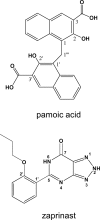

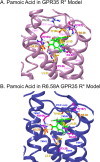
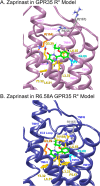

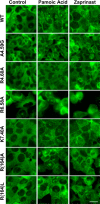
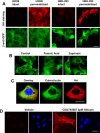


Similar articles
-
Agonist activation of the G protein-coupled receptor GPR35 involves transmembrane domain III and is transduced via Gα₁₃ and β-arrestin-2.Br J Pharmacol. 2011 Feb;162(3):733-48. doi: 10.1111/j.1476-5381.2010.01082.x. Br J Pharmacol. 2011. PMID: 20958291 Free PMC article.
-
Zaprinast, a well-known cyclic guanosine monophosphate-specific phosphodiesterase inhibitor, is an agonist for GPR35.FEBS Lett. 2006 Sep 18;580(21):5003-8. doi: 10.1016/j.febslet.2006.08.015. Epub 2006 Aug 17. FEBS Lett. 2006. PMID: 16934253
-
G-protein coupled receptor 35 (GPR35) activation and inflammatory pain: Studies on the antinociceptive effects of kynurenic acid and zaprinast.Neuropharmacology. 2011 Jun;60(7-8):1227-31. doi: 10.1016/j.neuropharm.2010.11.014. Epub 2010 Nov 24. Neuropharmacology. 2011. PMID: 21110987
-
Orthologue selectivity and ligand bias: translating the pharmacology of GPR35.Trends Pharmacol Sci. 2011 May;32(5):317-25. doi: 10.1016/j.tips.2011.02.002. Epub 2011 Mar 9. Trends Pharmacol Sci. 2011. PMID: 21392828 Review.
-
Recent advances in GPR35 pharmacology; 5-HIAA serotonin metabolite becomes a ligand.Arch Pharm Res. 2023 Jun;46(6):550-563. doi: 10.1007/s12272-023-01449-y. Epub 2023 May 25. Arch Pharm Res. 2023. PMID: 37227682 Review.
Cited by
-
The therapeutic potential of orphan GPCRs, GPR35 and GPR55.Front Pharmacol. 2015 Apr 15;6:69. doi: 10.3389/fphar.2015.00069. eCollection 2015. Front Pharmacol. 2015. PMID: 25926795 Free PMC article. Review.
-
Insights into divalent cation regulation and G13-coupling of orphan receptor GPR35.Cell Discov. 2022 Dec 21;8(1):135. doi: 10.1038/s41421-022-00499-8. Cell Discov. 2022. PMID: 36543774 Free PMC article.
-
Targeting Members of the Chemokine Family as a Novel Approach to Treating Neuropathic Pain.Molecules. 2023 Jul 30;28(15):5766. doi: 10.3390/molecules28155766. Molecules. 2023. PMID: 37570736 Free PMC article. Review.
-
Mitochondrial remodeling and ischemic protection by G protein-coupled receptor 35 agonists.Science. 2022 Aug 5;377(6606):621-629. doi: 10.1126/science.abm1638. Epub 2022 Aug 4. Science. 2022. PMID: 35926043 Free PMC article.
-
Therapeutic Opportunities and Challenges in Targeting the Orphan G Protein-Coupled Receptor GPR35.ACS Pharmacol Transl Sci. 2020 Jul 29;3(5):801-812. doi: 10.1021/acsptsci.0c00079. eCollection 2020 Oct 9. ACS Pharmacol Transl Sci. 2020. PMID: 33073184 Free PMC article. Review.
References
-
- O'Dowd B. F., Nguyen T., Marchese A., Cheng R., Lynch K. R., Heng H. H., Kolakowski L. F., Jr., George S. R. (1998) Discovery of three novel G-protein-coupled receptor genes. Genomics 47, 310–313 - PubMed
-
- Guo J., Williams D. J., Puhl H. L., 3rd, Ikeda S. R. (2008) Inhibition of N-type calcium channels by activation of GPR35, an orphan receptor, heterologously expressed in rat sympathetic neurons. J. Pharmacol. Exp. Ther. 324, 342–351 - PubMed
-
- Ohshiro H., Tonai-Kachi H., Ichikawa K. (2008) GPR35 is a functional receptor in rat dorsal root ganglion neurons. Biochem. Biophys. Res. Commun. 365, 344–348 - PubMed
-
- Taniguchi Y., Tonai-Kachi H., Shinjo K. (2006) Zaprinast, a well-known cyclic guanosine monophosphate-specific phosphodiesterase inhibitor, is an agonist for GPR35. FEBS Lett. 580, 5003–5008 - PubMed
-
- Zhao P., Sharir H., Kapur A., Cowan A., Geller E. B., Adler M. W., Seltzman H. H., Reggio P. H., Heynen-Genel S., Sauer M., Chung T. D., Bai Y., Chen W., Caron M. G., Barak L. S., Abood M. E. (2010) Targeting of the orphan receptor GPR35 by pamoic acid. A potent activator of extracellular signal-regulated kinase and β-arrestin2 with antinociceptive activity. Mol. Pharmacol. 78, 560–568 - PMC - PubMed
Publication types
MeSH terms
Substances
Grants and funding
LinkOut - more resources
Full Text Sources
Other Literature Sources
Research Materials
Miscellaneous

